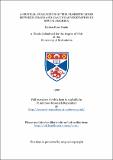Files in this item
A critical evaluation of the floristic links between Chaco and Caatingas vegetation in South America
Item metadata
| dc.contributor.advisor | Gibbs, Peter | |
| dc.contributor.author | Prado, Darien Eros | |
| dc.coverage.spatial | 283 p. | en_US |
| dc.date.accessioned | 2018-06-15T13:11:44Z | |
| dc.date.available | 2018-06-15T13:11:44Z | |
| dc.date.issued | 1992 | |
| dc.identifier.uri | https://hdl.handle.net/10023/14121 | |
| dc.description.abstract | The present study critically evaluates the alleged close floristic links between Chaco and Caatingas vegetation in South America. A reassessment of the phytogeography of these areas has been made by (a) comparing species lists in virtually all of the available literature, and (b) plotting dot-map distributions of relevant taxa based on the author's own herbarium studies and recent monographs. The environmental factors, geology and geomorphology, climate and soils of both areas were also analyzed to assess their degree of internal coherence. The prevailing concept of the Chaco itself proved to be a broad geographical entity rather than a well-defined geobotanic unit in vegetational terms, and a redefinition of the Chaco sensu stricto and a new map of the province has been proposed. Several forest communities have been excluded from the Chaco s.s. since their floristic composition clearly link them to other neighbouring provinces. Although the Caatingas province vegetation is not so well known, the area appears to be a consistent natural region, and a new vegetation type has been briefly described. Detailed floristic lists of the main woody and succulent species of the Chaco s.s., the Caatingas and the Subandean Piedmont Forests are presented, which provide the basis for a subsequent phytosociological analyses (classical and numerical approaches) of these vegetation units vis-a-vis the rest of the seasonal forests and woodlands of South America. The results suggest that the alleged affinities Chaco-Caatingas are very feeble indeed, particularly when they are compared to the actual links between the Caatingas and other seasonal communities in the continent: the Guajira province in N Colombia and Venezuela, the dry forests of W Ecuador, and very particularly the Subandean Piedmont Forests in NW Argentina and SW Bolivia. Some basic patterns of distribution of the floristic elements of seasonal forests in South America have been identified and found to form coherent trends in a series of accurate dot maps: a) Chaco endemics; b) Caatingas endemics; c) Neotropical seasonal forests pattern, including c.1- Residual Pleistocenic Seasonal Formations Arc (or 'Pleistocenic Arc'), extending from the Caatingas through some Planalto forests and calcium-rich localities in the Cerrados, SW Mato Grosso do Sul and the Santiago and Chiquitos Sierras, to the Parana-Paraguay river system and the Subandean Piedmont Forests; c.2- Tropical and Subtropical Seasonal Forests in South America; and c.3- Amphitropical Seasonal Forests pattern. The zoological evidence regarded until present as further proof of the Chaco-Caatingas links is also analysed and mapped, and the results are sharply coincidental with those found for plant distribution. An attempt has also been made to interpret the origin of the Caatingas flora; a hypothetical framework of probable ancient connections across South America between present-day seasonal woody communities is postulated, which have been interpreted here as migratory routes during the wet-dry climatic fluctuations of the late Pleistocene (18-12 ka BP). It is therefore concluded that the floristic links between the Chaco and the Caatingas are very weak and negligible when compared to other relationships, such as those between Chaco-Monte or Caatingas-Subandean Piedmont Forests. It is proposed that the Caatingas should be removed from the Chaquenian Dominium and placed in the Amazonian Dominium, with which they show much stronger affinities. | en_US |
| dc.language.iso | en | en_US |
| dc.publisher | University of St Andrews | |
| dc.subject.lcc | QK241.P8 | en |
| dc.subject.lcsh | Phytogeography | en |
| dc.title | A critical evaluation of the floristic links between Chaco and Caatingas vegetation in South America | en_US |
| dc.type | Thesis | en_US |
| dc.contributor.sponsor | Bianchi Foundation | en_US |
| dc.type.qualificationlevel | Doctoral | en_US |
| dc.type.qualificationname | PhD Doctor of Philosophy | en_US |
| dc.publisher.institution | The University of St Andrews | en_US |
This item appears in the following Collection(s)
Items in the St Andrews Research Repository are protected by copyright, with all rights reserved, unless otherwise indicated.

